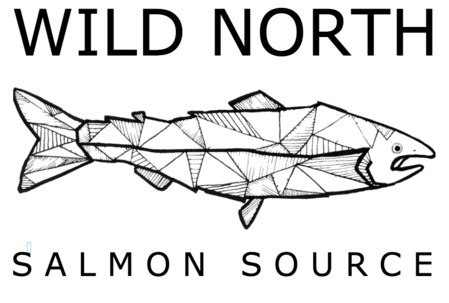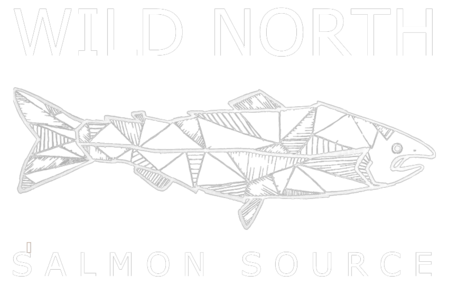FAQ's
How much salmon should I order?
We are catering to salmon lovers who will put up enough salmon in their freezer to enjoy year round. To make sure your fish tastes the freshest we recommend only storing it for one year. Ten and twenty pounds may sound like a lot of fish, but realize that if two people ate a one pound salmon dinner every other week for a year they would consume 26 pounds. We eat salmon at least once a week, so we put up 50 pounds, just for the 2 of us! If 10 or 20 pounds is too much for you, we encourage you to split your order with friends, family or neighbors.
How big is a fillet / how big is a portion?
A salmon fillet means HALF of a salmon! Fillets are about 1.3 pounds. A filet feeds about 5 people. Portions are pieces of fillets (5-7oz.) that feed one person.
How much freezer space do I need to store my share of salmon?
20 pounds of salmon packaged in one pound servings takes up a volume of about 1 cubic foot (1740 cubic inches to be more exact). 10 pounds individually packaged portions and fillets take up half a cubic foot. Realize that because you receive about 10 or 20 packages you can tuck these in to smaller spaces in your freezer.
What kind of salmon is it?
All of the salmon we catch and sell is Sockeye Salmon, which is also called Red Salmon. It is called"niklliq" and "Aanux̂" in the Alutiiq and Aleut Native Alaskan languages.

Sockeye salmon freshly caught aboard the Eva.
What is the mercury content of this salmon?
We do not test our salmon specifically but because salmon spend most of their life at sea mercury levels are similar for all Wild Pacific Salmon. Fortunately, Wild Pacific Salmon are ranked as Very Low/Least Mercury by the FDA and EPA. Seafood in this category is “recommended as the best-choice” and “should be enjoyed.” Check out the or the WHFood List of mercury rankings for more information.
When will I get my salmon?
Salmon will be delivered to Crested Butte and Denver beginning in October until we run out of this year's shipment. Every few weeks we will make deliveries depending on location and order volume. Upon receiving your order we will get in touch with you about the delivery of your salmon.
Where is this salmon from?
We fish exclusively in Bristol Bay, which is part of the Bering Sea on the north side of the Alaska Peninsula. There are no roads in this part of the sate, you have to arrive by boat or plane.


Pilot Point is the village nearest to where we fish. About 40 People live in Pilot Point year-round.
Why Wild?
We could go on for days! Wild salmon is far superior to farmed salmon. It is far better for you and our oceans, and I'll tell you why:
Wild salmon spend their whole lives in their natural habitat of both fresh and saltwater. The brilliant color of their flesh comes from a diet rich in plankton. Conversely, farmed salmon are raised quickly in crowded "net-pens" that create considerable waste and disease in ocean surrounding the pens. They are fed antibiotics to combat disease, bred in crowded conditions, and pumped with dye to replicate the color of wild salmon.

PCB (Polychlorinated biphenyls) concentrations in farmed salmon were found to be eight times higher than in wild salmon. PCB's are a group of manufactured chemicals that are used in coolants and lubricants and other electrical equipment. The United Sates stopped making PCBs in 1977 because of evidence that they build up in the environment and cause harmful health effects, PCB is a probable carcinogen.
Here are some important differences in nutritional composition of farmed and wild salmon:

Nutritional differences between wild and farmed salmon are significant. Farmed salmon is much higher in fat but not the good kind. It contains just slightly more Omega-3 fatty acids (good stuff!), but much more Omega-6 fatty acids (bad stuff!!) and 3x the amount of saturated fat. It also contains 46% more calories, mostly from fat. Conversely, wild salmon is higher in minerals, including potassium, zinc and iron.
Here is a great infographic describing how wild and farmed salmon impact our health and our environment.
Why is salmon good for me?
Wild salmon is a great source of lean protein, and its delicious! Salmon is good for our bodies and brains, it is especially good for kids and babies. Here are just a few reasons:
- Omega-3 is a type of fat that our bodies need to function. A diet high is omega-3 lowers levels of triglycerides (a type of fat in your blood, which if too high increases your risk of heart disease). Omega-3 is also an integral part of cell membranes throughout the body, they provide the starting point for making hormones that regulate blood clotting, contraction and relaxation of artery walls, and inflammation. Due to these effects, omega-3 fats have been shown to help prevent heart disease and stroke, may help control lupus, eczema, and rheumatoid arthritis, and may play protective roles in cancer and other conditions. Here is a great resource for learning more about Omega-3 vs. Omega-6.
- Vitamin B12 is a nutrient that helps keep the body's nerve and blood cells healthy and helps make DNA. Vitamin B12 also helps prevent a type of anemia called megaloblastic anemia that makes people tired and weak.
How is it sustainable?
Bristol Bay has sustained a commercial salmon fishing industry for over 100 years and maintains a robust salmon population. The population where we fish is closely monitored by fish biologists. The biologist tell the fishermen on a daily basis when and where they can fish.


Commercial salmon fishing in Bristol Bay Circa 1935.
The Monterey Bay Aquarium has recently determined Alaskan salmon to be the only low-risk salmon in terms of 4 sustainability criteria:
- Inherent vulnerability of the fish population
- Effects of fishing on the overall habitat
- Status of wild stocks
- Nature and amount of the by-catch.
Here is additional information on the sustainability of Alaska fisheries.
How is this salmon caught?
This is a great video that describes the process of "drift gill-net" fishing, which is the classification of fishing we do!
How do I prepare my Salmon?
We recommend you keep your fish frozen until the day before you plan to cook it and thaw it overnight in your refrigerator. If you are in a hurry it also thaws in about 25 minutes if you submerge your vacuum-packed fillet or portions in cool water.
As a general rule cook for 10 minutes per inch of thickness. Salmon should be slightly translucent when you stop cooking it.
There are SO many ways to prepare salmon. Visit Alaska Seafood's Salmon Recipe Collection and The Recipe Gallery for delicious recipes!









